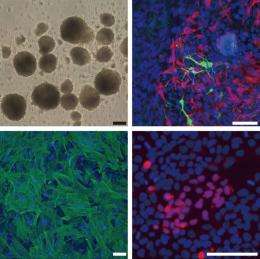Adult rabbit stem cells show good potential for laboratory use

Japanese molecular biologists have successfully reprogrammed adult rabbit body cells to form colonies of fully pluripotent cells that are highly similar to rabbit embryonic stem cells (ESCs).
These induced pluripotent stem (iPS) cells of rabbits are likely to be used as a laboratory model of human iPS cells, the researchers say -- in particular, for comparisons with ESCs to evaluate the feasibility of iPS cells for regenerative medicine.
In fact, the researchers consider the development of these rabbit iPS cells as an important tool for human medical research, as rabbits are much closer to humans physiologically than mice and can be handled much more easily in the laboratory than other animals used as models of humans, such as pigs and monkeys.
The research team from the RIKEN BioResource Center in Tsukuba, which was led by Atsuo Ogura, used lentiviruses modified as vectors to introduce four human genes into adult rabbit liver and stomach cells1. The genes -- for transcription factors that guide reading of the DNA -- effectively reprogrammed the adult cells as iPS cells, and these proved easy to handle and maintain in culture. But the result was dependent on the initial adult cell-type, according to Arata Honda, a researcher in Ogura’s team.
Honda says that the researchers first tried without success to reprogram adult rabbit fibroblasts, the most common cells in connective tissue.
They tested the properties of the rabbit iPS cells by using them to generate the tumors known as teratomas that contain differentiated or specialized cells of all three types of germ layers -- ectoderm, endoderm and mesoderm. Marker compounds that are characteristic of stem cells were present in the iPS cells.
Ogura, Honda and colleagues also determined which genes were active in their rabbit iPS cells. When they compared the profile of this activity with that found for rabbit ESCs, they found that, although not the same, the two types of cells were very similar.
At least three types of pluripotent cells, generated from rabbits by different methods, are now available to researchers—ES cells, iPS cells, and nuclear transfer ES cells. “Thus, using rabbits, we can fully characterize these different pluripotent cells in parallel under the same experimental conditions,” Ogura says.
Honda adds that: “We can now assess the efficacy and safety of new cell-based treatments for degenerative diseases in human. We hope that we will finally identify which type of cells is best suited for each purpose of regenerative therapy in humans.”
More information: Honda, A., et al. Generation of induced pluripotent stem cells in rabbits: potential experimental models for human regenerative medicine. Journal of Biological Chemistry published online 29 July 2010, doi:10.1074/jbc.M110.150540
Provided by RIKEN














